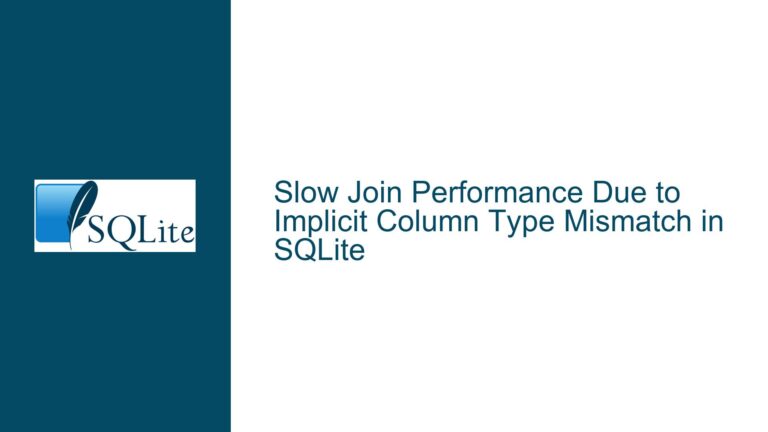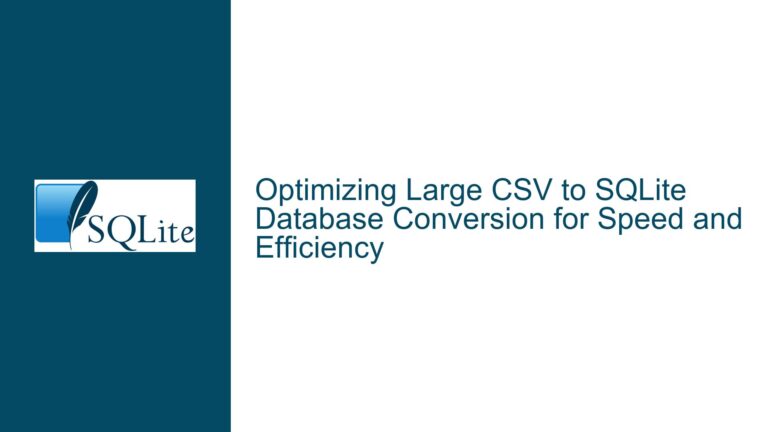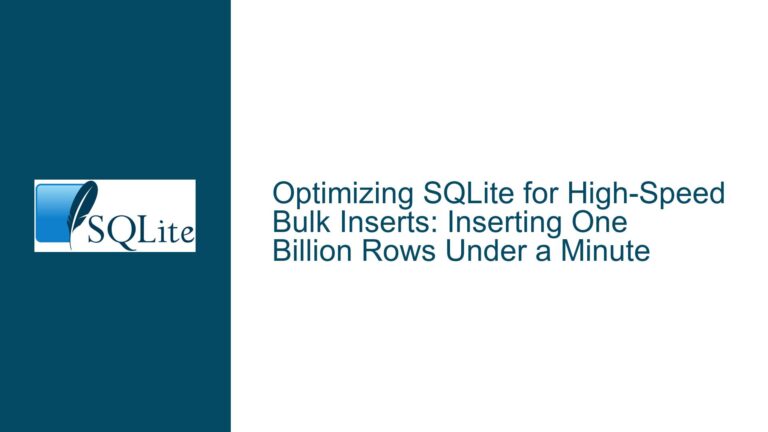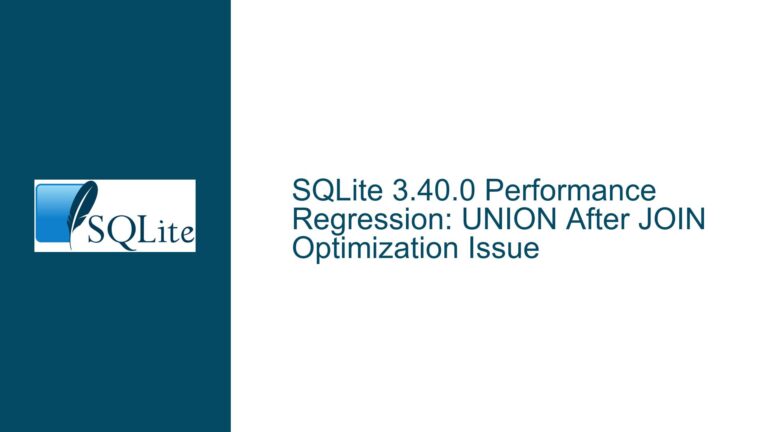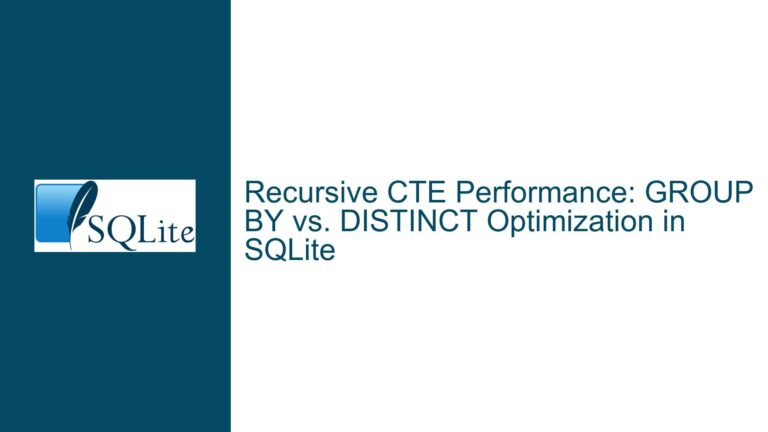Automatic Covering Indexes for Virtual Tables in SQLite: Challenges and Solutions
Virtual Table Performance Issues Without Index Support
When working with virtual tables in SQLite, one of the most common performance bottlenecks arises when joining or querying tables that lack index support. Virtual tables, unlike regular tables, do not inherently support indexing unless explicitly implemented by the module developer. This can lead to full table scans, which are computationally expensive and result in slow query execution, especially for medium to large datasets.
For example, consider a scenario where two virtual tables, namespace and string, are joined without any indexing support. The query planner is forced to perform a full scan on both tables, as indicated by the VIRTUAL TABLE INDEX 0: output in the query plan. This is because the xBestIndex function, which is responsible for providing the query planner with cost estimates and indexing strategies, is not implemented to support indexing. As a result, the query planner defaults to a full scan, which is inefficient for operations like joins or filtered queries.
In contrast, when the same data is stored in temporary tables (temp.namespace1 and temp.string1), SQLite automatically creates a covering index to optimize the query. This is evident in the query plan, where the temporary table string1 is accessed using an automatic covering index (AUTOMATIC COVERING INDEX (id=?)). This discrepancy highlights the performance gap between virtual tables and regular tables when indexing is not explicitly supported.
The core issue lies in the fact that virtual tables do not benefit from SQLite’s automatic indexing mechanism. Automatic indexes are created by SQLite to optimize queries on regular tables, but this feature is not extended to virtual tables. This limitation forces developers to implement their own indexing strategies within the virtual table module, which can be complex and time-consuming.
Limitations of xBestIndex Implementation and Automatic Indexing
The inability of virtual tables to leverage automatic indexing stems from the implementation of the xBestIndex function. This function is a critical component of the virtual table interface, as it communicates indexing capabilities and cost estimates to the SQLite query planner. When xBestIndex is not properly implemented, the query planner assumes that the virtual table does not support any form of indexing, leading to suboptimal query plans.
In the case of the namespace and string virtual tables, the xBestIndex function sets estimatedCost to an arbitrarily high value (100000) and returns OK. This signals to the query planner that accessing the table is expensive and that no indexing strategies are available. As a result, the query planner defaults to a full table scan, which is the least efficient access method.
To enable indexing for virtual tables, the xBestIndex function must provide accurate cost estimates and support for rowid-based access. The estimatedCost value should reflect the actual number of disk accesses or rows scanned, rather than an arbitrary high value. Additionally, the function should set the UNIQUE flag and provide argvIndex and omit fields for rowid constraints. This allows the query planner to optimize queries by leveraging rowid-based access, which is significantly faster than full table scans.
However, even with a properly implemented xBestIndex function, virtual tables cannot automatically create covering indexes like regular tables. This is because automatic indexing is a feature of SQLite’s internal query planner, which does not interact with virtual tables in the same way as regular tables. As a result, developers must manually implement indexing strategies within the virtual table module, such as creating temporary tables or materialized views to simulate automatic indexing.
Implementing Custom Indexing Strategies for Virtual Tables
Given the limitations of automatic indexing for virtual tables, developers must implement custom indexing strategies to optimize query performance. One approach is to materialize the virtual table data into a temporary table, which can then benefit from SQLite’s automatic indexing mechanism. This involves creating a temporary table that mirrors the structure of the virtual table and populating it with the same data. Once the data is materialized, queries can leverage automatic indexes to improve performance.
For example, consider the following steps to materialize the namespace virtual table into a temporary table:
Create a temporary table with the same schema as the virtual table:
CREATE TEMPORARY TABLE temp.namespace1 AS SELECT * FROM namespace;Query the temporary table instead of the virtual table:
SELECT namespace1.id, string1.string FROM namespace1 LEFT JOIN string1 ON parentId = string1.id LIMIT 10;
This approach allows the query planner to create an automatic covering index for the temporary table, significantly improving query performance. However, it comes with the trade-off of increased storage and memory usage, as the data is duplicated in the temporary table.
Another approach is to implement rowid-based access within the virtual table module. This involves modifying the xBestIndex function to support rowid constraints and providing accurate cost estimates. By enabling rowid-based access, the query planner can optimize queries by directly accessing specific rows, rather than performing full table scans.
For example, the xBestIndex function can be modified as follows:
Set
estimatedCostto the actual number of rows or disk accesses:pCost->estimatedCost = num_rows;Set the
UNIQUEflag and provideargvIndexandomitfields for rowid constraints:pConstraintUsage->argvIndex = 1; pConstraintUsage->omit = 1; pCost->plan.wsFlags |= WHERE_UNIQUE;Implement rowid-based access in the
xFilterfunction:int xFilter(sqlite3_vtab_cursor *pCursor, int idxNum, const char *idxStr, int argc, sqlite3_value **argv) { // Retrieve rowid from argv and filter rows accordingly sqlite3_int64 rowid = sqlite3_value_int64(argv[0]); // Fetch row data based on rowid }
By implementing these changes, the virtual table can support rowid-based access, allowing the query planner to optimize queries more effectively. This approach avoids the need for materializing data into temporary tables, but requires careful implementation to ensure accurate cost estimates and efficient rowid access.
In conclusion, while virtual tables in SQLite do not support automatic indexing, developers can implement custom indexing strategies to optimize query performance. By materializing data into temporary tables or enabling rowid-based access, virtual tables can achieve performance comparable to regular tables. However, these solutions require careful consideration of trade-offs, such as increased storage usage or implementation complexity. Ultimately, the choice of indexing strategy depends on the specific requirements and constraints of the application.

